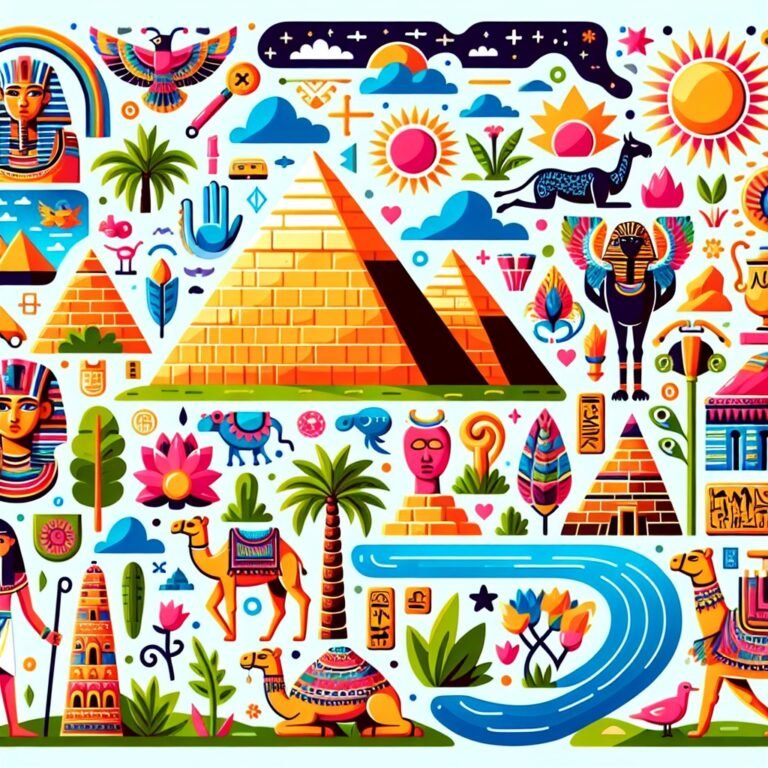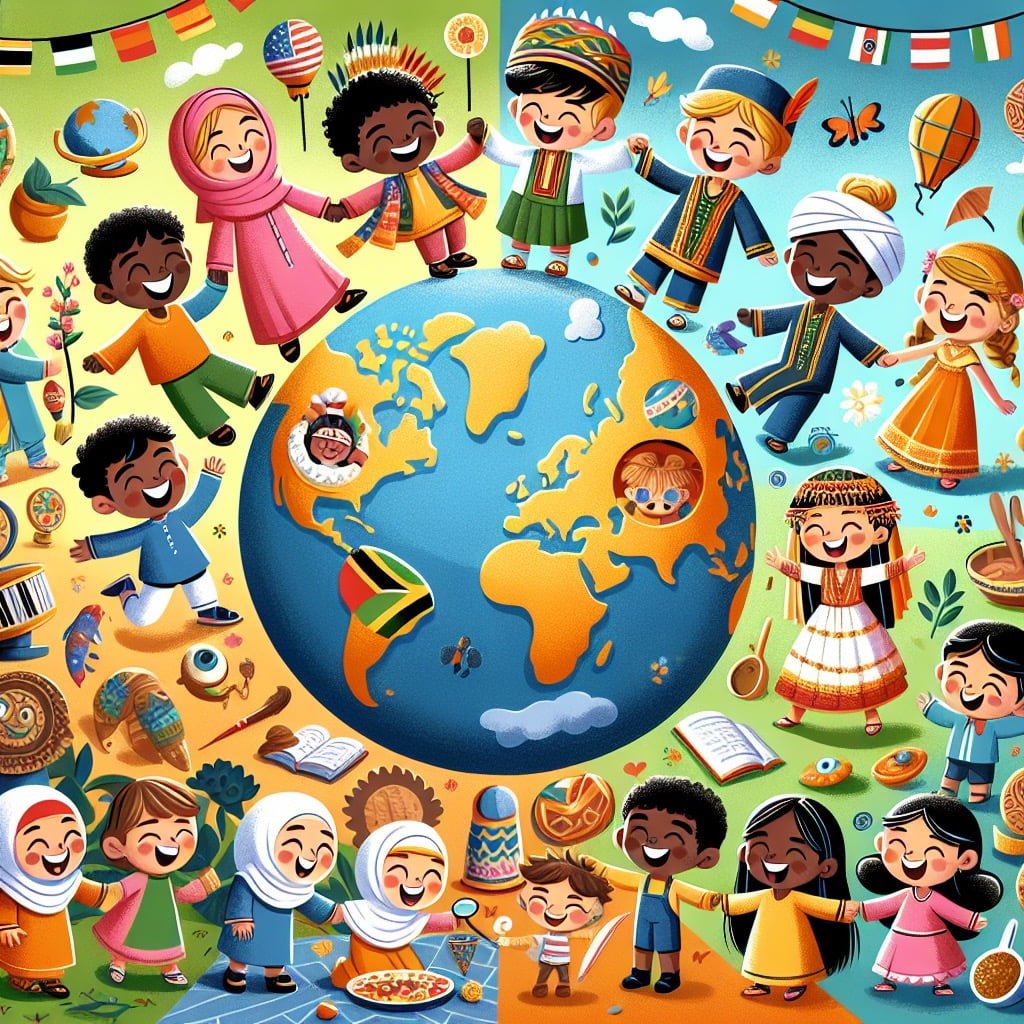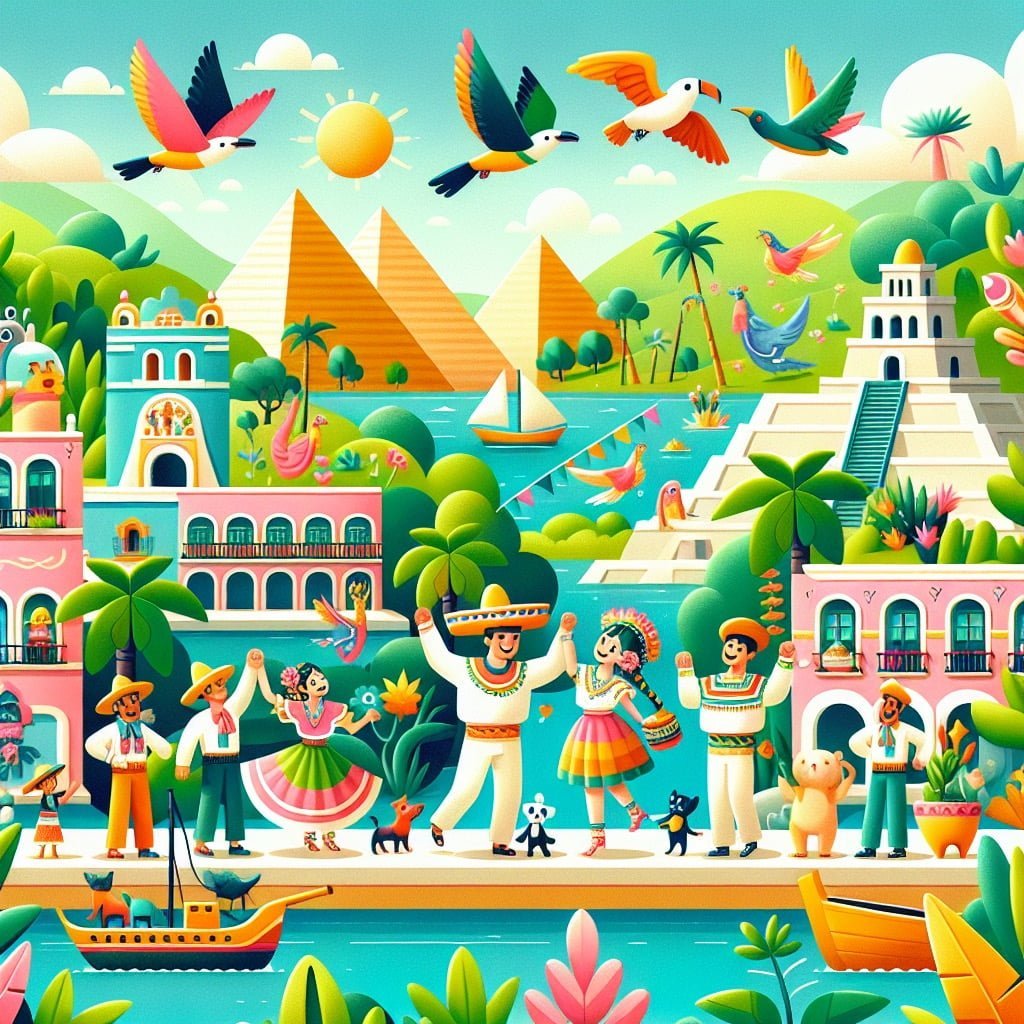Welcome to “Egypt’s Facts For Kids” – a fascinating journey into the ancient wonders of Egyptian civilization! Delve into the mysteries of the Great Sphinx of Giza, the longest river in the world, the majestic pyramids, and the legendary Cleopatra. Uncover the secrets of the Cat Goddess Bastet, the intricate hieroglyphics, and the Valley of the Kings. Learn about the powerful sun god Ra, the Rosetta Stone that deciphered hieroglyphics, and the treasures of King Tutankhamun. Whether you’re a young explorer or an older history enthusiast, there is something for everyone to discover in the captivating world of ancient Egypt. Join us as we unravel the rich tapestry of Egypt’s history and unlock its timeless secrets. Let’s embark on this exciting adventure together!
Egypts Facts For Kids
1. The Great Sphinx of Giza

For younger kids: The Sphinx has the body of a lion and the head of a pharaoh.
For older kids: The Great Sphinx of Giza is a monumental statue with the body of a lion and the face of a Pharaoh, believed to represent the Pharaoh Khafre.
Detailed explanation:The Great Sphinx of Giza is one of the most iconic and recognizable monuments in Egypt, capturing the imagination of people around the world, including Egypts Facts For Kids. This massive statue, which stands at over 66 feet tall and 240 feet long, is believed to have been built during the reign of Pharaoh Khafre in the 26th century BC. The Sphinx is carved out of limestone and depicts a mythical creature with the body of a lion and the head of a human, most likely the Pharaoh himself.
One of the most intriguing aspects of the Great Sphinx is its mysterious missing nose. There are numerous theories as to how the nose was lost, ranging from Napoleon’s soldiers shooting it off during target practice to it being destroyed by a Sufi Muslim named Muhammad Sa’im al-Dahr in the 14th century. Despite the missing nose, the Great Sphinx continues to awe and inspire visitors to this day.
The Great Sphinx is not only a symbol of Egypt but also a testament to the incredible engineering and artistic skills of the ancient Egyptians. The statue is strategically positioned facing the rising sun, symbolizing rebirth and renewal in Egyptian mythology. It is also thought to guard the Giza Plateau and the pyramids located nearby.
The Great Sphinx of Giza remains a source of fascination and intrigue, attracting millions of visitors each year who come to marvel at its size, beauty, and enigmatic presence. For Egypts Facts For Kids, learning about the history and significance of the Great Sphinx can open up a world of wonder and curiosity about the ancient civilization that created this magnificent monument.
Egypts Facts For Kids
2. The Nile River is the Longest in the World

For younger kids: The Nile is a super long river where Egyptian history began.
For older kids: The Nile River, stretching over 4,100 miles, is the longest river in the world and played a crucial role in the development of ancient Egyptian civilization.
Detailed explanation:Egypt’s Facts For Kids: The Nile River is indeed the longest river in the world, stretching over 4,135 miles in length. It is a major north-flowing river in northeastern Africa and has played a crucial role in the development of ancient Egyptian civilization. The Nile River is often referred to as the lifeblood of Egypt, as it provided a constant water source for irrigation, agriculture, and transportation.
One of the most fascinating aspects of the Nile River is its annual flooding, which brought nutrient-rich silt to the surrounding land, creating fertile soil for agriculture. This predictable flooding allowed the ancient Egyptians to develop advanced farming techniques and sustain a flourishing civilization along the banks of the river.
For kids learning about Egypt, the Nile River is not only an impressive geographical feature but also a symbol of the country’s rich history and cultural heritage. It served as a means of transportation for goods and people, connecting different regions of Egypt and facilitating trade and communication.
In addition to its historical significance, the Nile River is home to a diverse range of plant and animal species, making it an important ecosystem to study and protect. Kids fascinated by wildlife and nature can explore the unique habitats found along the Nile and learn about the conservation efforts being made to preserve this vital resource.
Overall, the Nile River is a fascinating subject for kids to explore, offering a blend of geography, history, and science in one of the most iconic landscapes in the world. Learning about the Nile River can inspire curiosity and appreciation for Egypt’s rich natural and cultural heritage.
Egypts Facts For Kids
3. The Pyramids Are Over 4,500 Years Old

For younger kids: The pyramids are giant, old tombs where Pharaohs were buried.
For older kids: The majestic pyramids of Egypt, such as the ones at Giza, were constructed over 4,500 years ago as elaborate tombs for Pharaohs and their families.
Detailed explanation:Egypt’s Facts For Kids: The Pyramids Are Over 4,500 Years Old
One of the most fascinating aspects of ancient Egypt that captivates both adults and children alike is the pyramids. These monumental structures, built as tombs for the pharaohs, are a testament to the advanced engineering and architectural skills of the ancient Egyptians. The most famous of all the pyramids is the Great Pyramid of Giza, built for Pharaoh Khufu around 4,500 years ago.
The age of the pyramids is truly mind-boggling, especially when considering the level of precision and planning that went into their construction. It is estimated that the Great Pyramid alone contains over 2 million blocks of stone, each weighing several tons. The fact that these massive stones were quarried, transported, and assembled with such incredible accuracy is a testament to the ingenuity of the ancient Egyptians.
For kids learning about ancient Egypt, the age of the pyramids serves as a reminder of just how ancient and advanced this civilization was. It provides a glimpse into the rich history and culture of a society that flourished thousands of years ago. Visiting the pyramids in person or exploring them through books and documentaries can ignite a sense of wonder and curiosity in young minds, inspiring them to learn more about the fascinating world of ancient Egypt.
In conclusion, the fact that the pyramids are over 4,500 years old is a remarkable testament to the lasting legacy of ancient Egypt. These incredible structures continue to capture the imagination of people of all ages, offering a window into a distant past that is both awe-inspiring and mysterious. Egypt’s Facts For Kids will undoubtedly continue to fascinate and educate generations to come.
Egypts Facts For Kids
4. Cleopatra Was the Last Pharaoh of Egypt

For younger kids: Cleopatra was a famous queen who lived a long time ago.
For older kids: Cleopatra is renowned as the last Pharaoh of Egypt and a powerful figure in history known for her intelligence, beauty, and political prowess.
Detailed explanation:Cleopatra is one of the most well-known historical figures, especially when it comes to ancient Egypt. She ruled as the last Pharaoh of Egypt, during a time when the country was facing threats from the expanding Roman Empire. Cleopatra was known for her intelligence, beauty, and political savvy, and she is often portrayed as a complex figure in history.
As the last Pharaoh of Egypt, Cleopatra’s reign marked the end of the Ptolemaic dynasty that had ruled the country for centuries. Her relationships with the Roman leaders Julius Caesar and Mark Antony are some of the most famous in history, and they played a significant role in the politics of the time. Cleopatra’s alliances with these powerful Roman figures helped to secure her own position of power in Egypt.
Despite being the last Pharaoh, Cleopatra’s reign was marked by political turmoil and internal conflict. The Roman influence in Egypt was growing stronger, and Cleopatra’s attempts to maintain control over her kingdom were met with opposition from within and outside of Egypt. In 30 BC, Cleopatra and Mark Antony were defeated by Octavian, the future Emperor Augustus, in the Battle of Actium. Rather than face capture, Cleopatra chose to take her own life, leading to the end of the Ptolemaic dynasty and Egypt’s status as an independent kingdom.
In conclusion, Cleopatra’s reign as the last Pharaoh of Egypt was a tumultuous time in the country’s history. Her alliances with powerful Roman leaders and her ultimate defeat marked the end of an era for Egypt. Learning about Cleopatra and her reign can provide valuable insight into the political and cultural landscape of ancient Egypt. Kids can find this fascinating story of Cleopatra as one of the interesting Egypts Facts For Kids to learn about.
Egypts Facts For Kids
5. A Cat Goddess Named Bastet
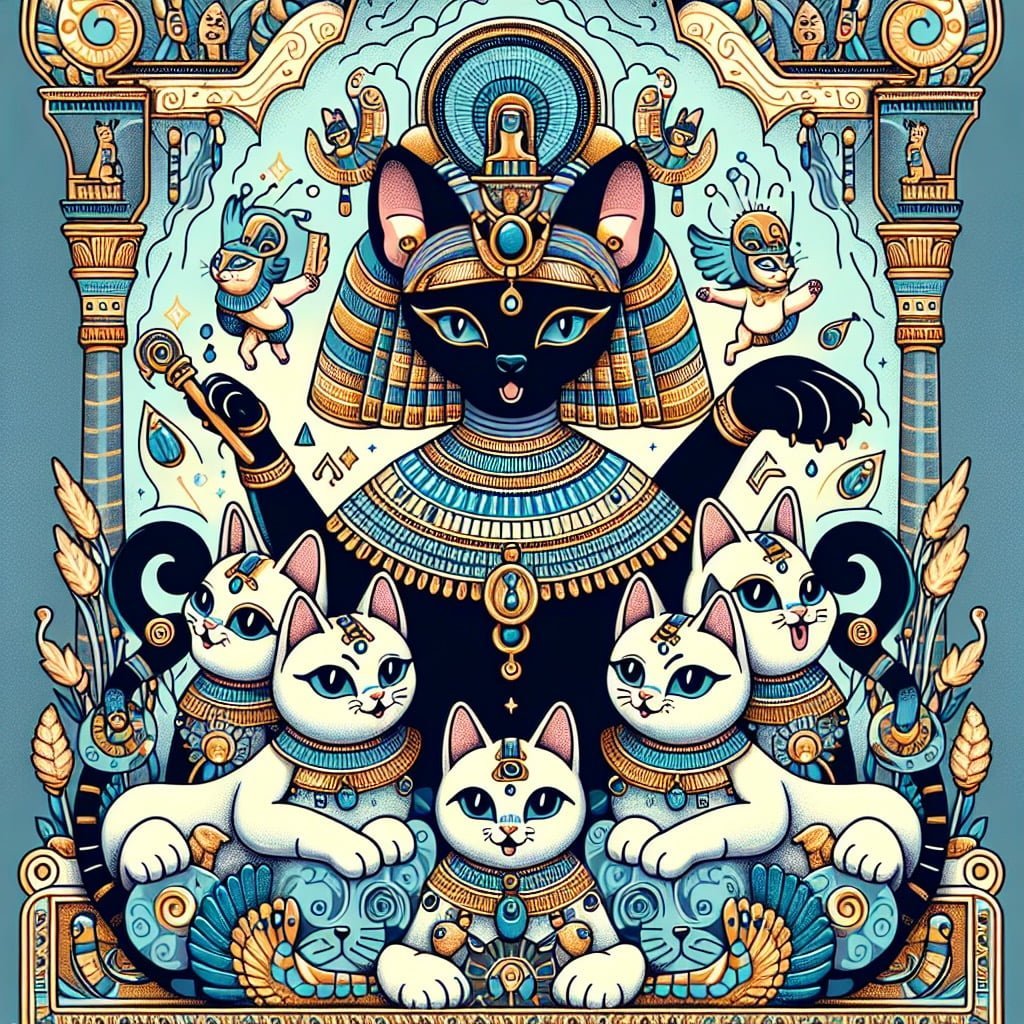
For younger kids: Bastet was a kind goddess with a head of a cat.
For older kids: Bastet was an ancient Egyptian goddess of home, fertility, and protection, often depicted with the head of a lioness or domestic cat.
Detailed explanation:Egypt’s Facts For Kids: A Cat Goddess Named Bastet
One of the fascinating facts about ancient Egypt that is sure to capture the interest of children is the existence of a cat goddess named Bastet. In ancient Egyptian mythology, Bastet was known as the goddess of home, fertility, and protection. She was often depicted as a lioness or as a woman with the head of a lioness. As a highly revered deity, Bastet was believed to have the power to protect households from evil spirits and to bring good luck and prosperity to her worshippers.
Bastet’s association with cats is particularly intriguing, as cats held a special significance in ancient Egypt. Cats were seen as sacred animals and were even worshipped as manifestations of the goddess herself. In fact, harming a cat was considered a serious crime in ancient Egypt and could result in severe punishment. Cats were thought to possess qualities such as grace, agility, and protection, all of which were attributes associated with Bastet.
Children learning about ancient Egypt will be amazed by the stories of Bastet and her feline companions. They will discover how the ancient Egyptians revered and worshipped animals, and how these beliefs influenced their daily lives and rituals. By exploring the mythology surrounding Bastet, children can gain a better understanding of the religious practices and beliefs of ancient Egypt.
In conclusion, the story of Bastet, the cat goddess of ancient Egypt, is a captivating tale that showcases the rich mythology and beliefs of this ancient civilization. By learning about Bastet and her importance in Egyptian society, children can gain a deeper appreciation for the culture and history of this fascinating civilization.
Egypts Facts For Kids
6. Hieroglyphics Are Ancient Egyptian Writing
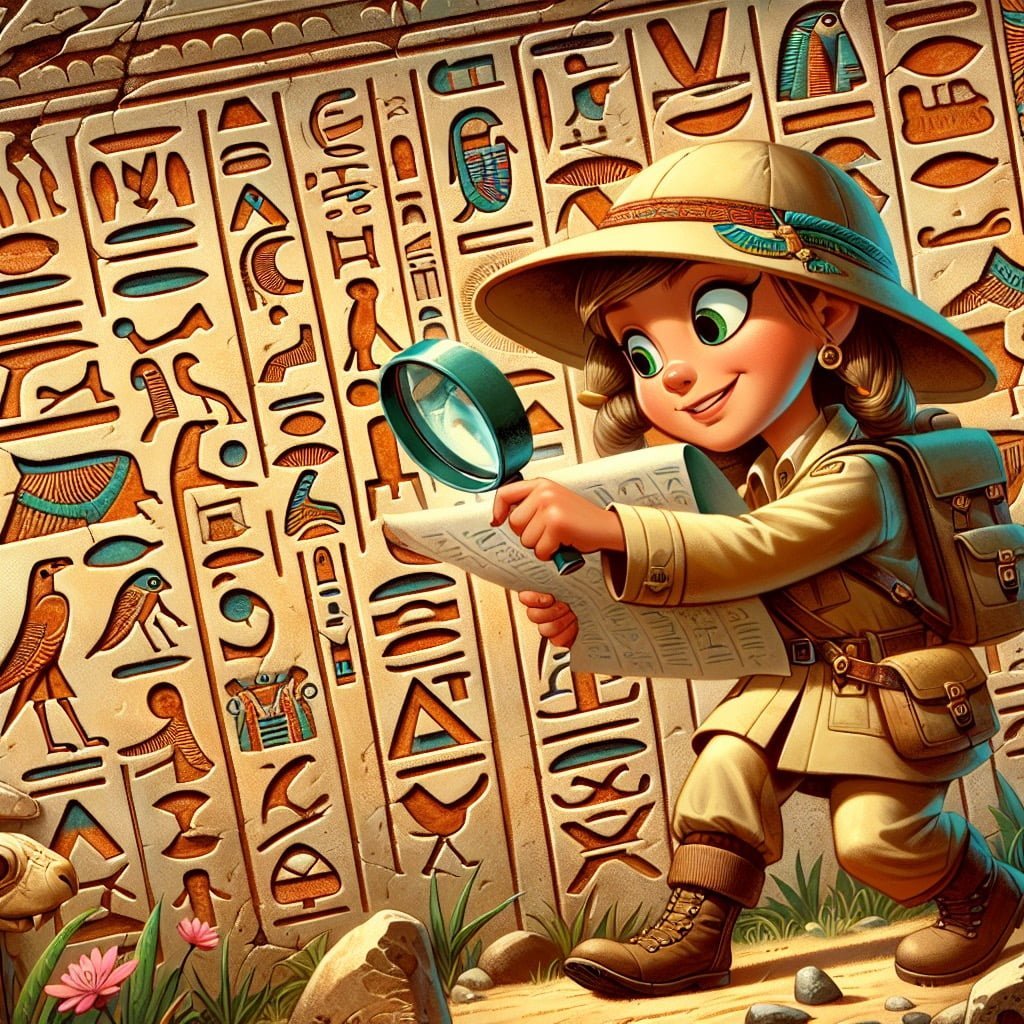
For younger kids: Hieroglyphics are cool drawings that Egyptians used to write.
For older kids: Hieroglyphics are the intricate system of writing used by ancient Egyptians, consisting of pictures and symbols that conveyed sounds and words.
Detailed explanation:Ancient Egyptian hieroglyphics are a fascinating form of writing that was used in Egypt for thousands of years. Hieroglyphics are a series of pictures and symbols that represent sounds and words, much like an alphabet used in modern languages. These intricate symbols were often carved into stone or written on papyrus, creating a written language that was both beautiful and complex.
Hieroglyphics played a critical role in ancient Egyptian society, as they were used for religious texts, historical records, and even everyday communication. The Egyptians believed that hieroglyphics held magical powers, and they were often used in religious ceremonies and rituals. Over time, the language evolved and became more standardized, with scribes being trained to specifically write in hieroglyphics.
One of the most famous examples of hieroglyphics is the Rosetta Stone, discovered in 1799. This stone slab contained the same decree written in three languages: hieroglyphics, Demotic script, and Greek. This discovery was crucial in deciphering the ancient Egyptian language, as scholars were able to use the Greek text as a key to unlock the meaning of the hieroglyphics.
Today, hieroglyphics remain a key part of Egypt’s history and culture. They are studied by scholars and Egyptologists to gain insight into the daily lives and beliefs of the ancient Egyptians. Egypts Facts For Kids can learn about hieroglyphics through books, museum exhibits, and even hands-on activities that allow them to try their hand at deciphering these ancient symbols. By understanding hieroglyphics, we can unlock the mysteries of Egypt’s past and appreciate the rich heritage of this ancient civilization.
Egypts Facts For Kids
7. The Valley of the Kings

For younger kids: The Valley of the Kings is a spooky but exciting place with many tombs.
For older kids: The Valley of the Kings is a famous archaeological site in Egypt where numerous pharaohs were buried in elaborate tombs filled with treasures and artifacts.
Detailed explanation:The Valley of the Kings, located near the ancient city of Thebes in Egypt, is a fascinating archaeological site that has captured the imagination of people around the world, including Egypts Facts For Kids. This valley served as a burial ground for pharaohs and other powerful nobles during the New Kingdom period, roughly between 16th to 11th century BC.
One of the most intriguing aspects of the Valley of the Kings is the elaborate tombs that were carved into the rock cliffs. These tombs were designed to protect the bodies of the deceased rulers and ensure their safe passage to the afterlife. The tombs were filled with treasures, furniture, food, and other items that the deceased would need in the next world.
Despite being looted over the centuries, many of the tombs in the Valley of the Kings have yielded incredible archaeological finds, including well-preserved mummies, intricate wall paintings, and hieroglyphic inscriptions. One of the most famous discoveries in the valley was the tomb of Tutankhamun, also known as King Tut, which was found almost intact in 1922 by Howard Carter. This discovery shed light on the burial practices and beliefs of the ancient Egyptians.
The Valley of the Kings continues to be a major tourist attraction in Egypt, drawing visitors from all over the world who are eager to explore the mysterious tombs and learn about the fascinating history of this ancient civilization. For Egypts Facts For Kids, a visit to the Valley of the Kings offers a unique opportunity to step back in time and discover the secrets of the pharaohs.
Egypts Facts For Kids
8. The Ancient Egyptian God Ra

For younger kids: Ra was the powerful sun god who made the sun rise every day.
For older kids: Ra was the ancient Egyptian sun god, considered one of the most important deities, symbolizing creation, life, and warmth.
Detailed explanation:Ancient Egypt was a civilization that worshipped a plethora of gods and goddesses, each representing different aspects of life and nature. One of the most prominent and influential deities in the ancient Egyptian pantheon was the sun god Ra. Ra was believed to be the creator of all things and the ruler of the heavens. He was often depicted as a man with the head of a falcon and a sun disk on his head, symbolizing his role as the sun god.
Ra was thought to travel across the sky during the day in a solar boat, bringing light and warmth to the world. At night, he would journey through the underworld, where he would do battle with the serpent Apophis in order to ensure that the sun would rise again in the morning. This cycle of death and rebirth was central to the ancient Egyptians’ understanding of the world and the afterlife.
Ra was also closely associated with kingship and pharaohs, who were believed to be his earthly representatives. The pharaoh was seen as a living god, embodying the divine authority of Ra and ensuring order and stability in the land. The pyramids, temples, and tombs built in ancient Egypt were all dedicated to honoring Ra and the other gods, and providing for their needs in the afterlife.
In conclusion, the ancient Egyptian god Ra was a central figure in the religious beliefs and practices of the civilization, representing the power of the sun and the cycle of life and death. His influence can still be seen in the art, architecture, and mythology of Egypt to this day. Learning about Egypts Facts For Kids can provide a fascinating insight into the rich and complex world of ancient Egyptian culture and belief systems.
Egypts Facts For Kids
9. The Rosetta Stone Helped Decipher Hieroglyphics
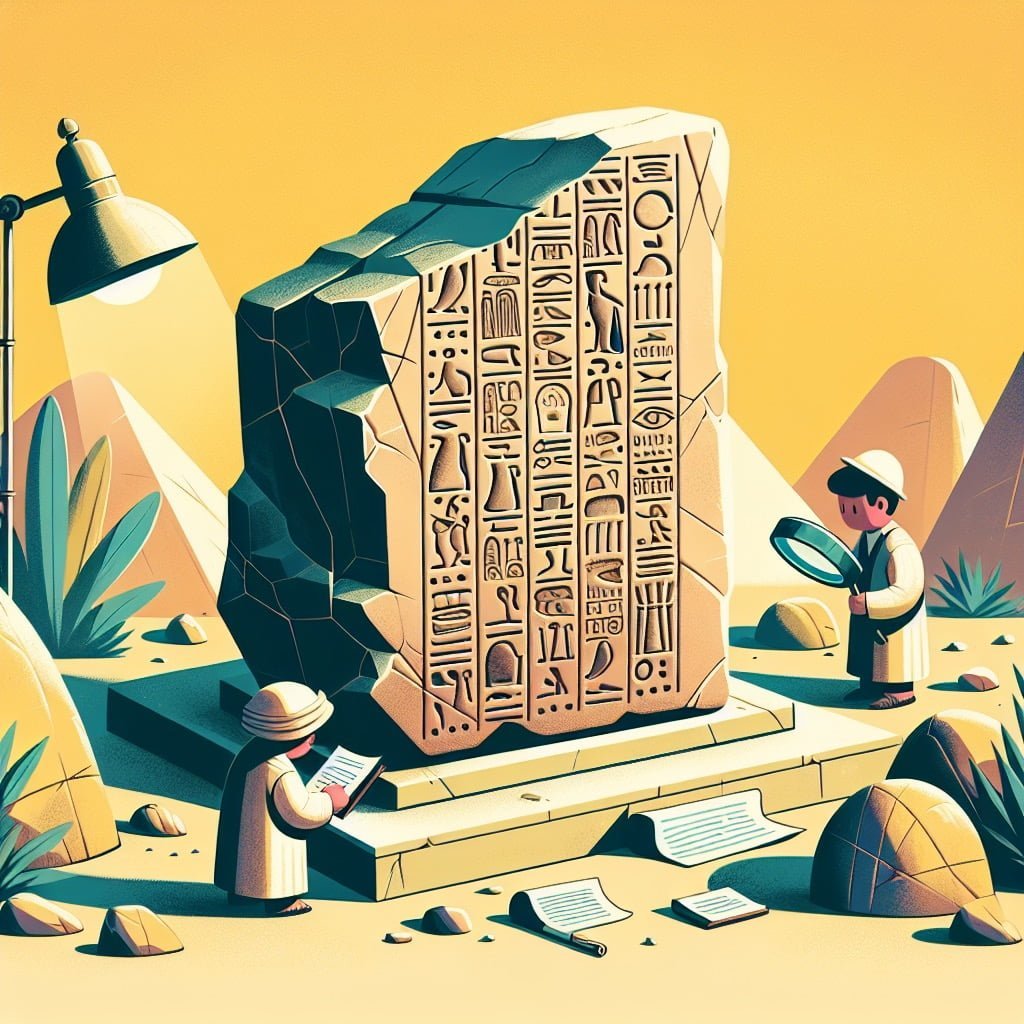
For younger kids: The Rosetta Stone is a big rock with writing that helped people understand Egyptian writings.
For older kids: The Rosetta Stone was a crucial discovery in Egypt that contained inscriptions in three languages, enabling scholars to decipher and understand the ancient hieroglyphics.
Detailed explanation:The Rosetta Stone is a significant archaeological discovery that played a crucial role in deciphering ancient Egyptian hieroglyphics. Discovered in 1799 in the Egyptian village of Rosetta by French soldiers during Napoleon’s campaign in Egypt, the Rosetta Stone is a large inscribed stone slab dating back to 196 BCE. It contains a decree issued by King Ptolemy V in three scripts: Ancient Greek, Demotic script, and hieroglyphics.
At the time of its discovery, hieroglyphics were already a lost language, no longer understood or used by the Egyptians. The discovery of the Rosetta Stone provided scholars with the key they needed to unlock the mysteries of hieroglyphics. By comparing the known Greek text on the stone with the unknown hieroglyphic text, scholars were able to start deciphering the hieroglyphics.
The Rosetta Stone’s inscription was essentially a translation of the same decree in three different scripts, allowing scholars to piece together the meaning of the hieroglyphic symbols and understand their phonetic and symbolic significance. This breakthrough in deciphering hieroglyphics opened up a whole new understanding of ancient Egyptian culture, history, and language.
For Egypts Facts For Kids, the story of the Rosetta Stone is not only a fascinating archaeological discovery but also a testament to the power of perseverance, collaboration, and ingenuity in unraveling the mysteries of the past. It serves as a reminder of the importance of preserving and studying ancient artifacts to gain insights into our shared human history.
Egypts Facts For Kids
10. Tutankhamun’s Treasures
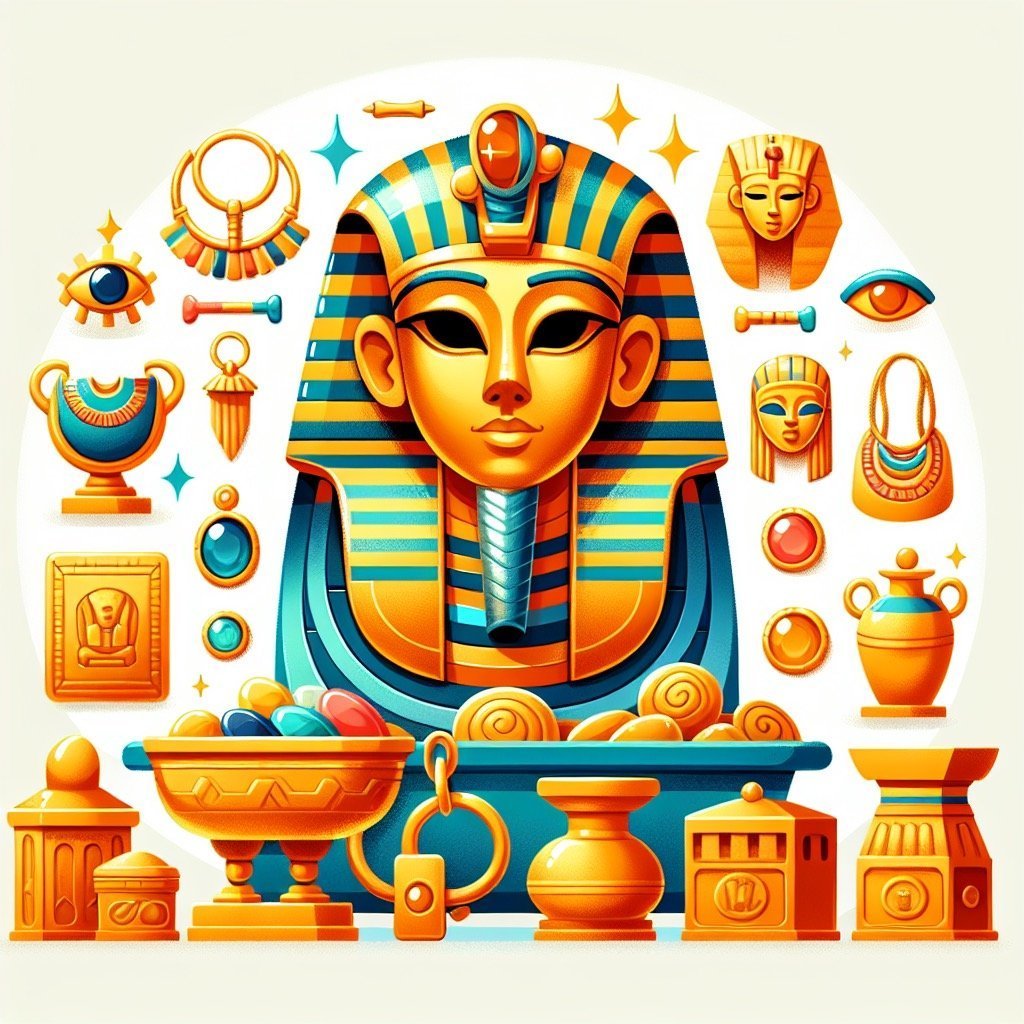
For younger kids: King Tut had a lot of gold and shiny treasures in his tomb.
For older kids: King Tutankhamun’s tomb, discovered nearly intact, contained a wealth of treasures, including his famous golden death mask and invaluable artifacts that provide insights into ancient Egyptian culture.
Detailed explanation:One of the most fascinating aspects of ancient Egyptian history is the discovery of Tutankhamun’s treasures. Tutankhamun, also known as King Tut, was a pharaoh of Egypt who ruled during the 18th dynasty (around 1332–1323 BC). His tomb, located in the Valley of the Kings, was discovered nearly intact by archaeologist Howard Carter in 1922.
The treasures found in Tutankhamun’s tomb provide valuable insights into the culture, beliefs, and practices of ancient Egypt. The tomb contained a vast array of artifacts, including furniture, clothing, chariots, weapons, and jewelry, all meticulously preserved for over 3,000 years. Among the most famous treasures found in the tomb is the solid gold death mask of Tutankhamun, adorned with precious gemstones and intricate designs.
The discovery of Tutankhamun’s tomb sparked worldwide fascination with ancient Egypt and has since become synonymous with the allure of Egyptian archaeology. The treasures found within the tomb have been meticulously cataloged, studied, and displayed in museums around the world, allowing people of all ages to marvel at the splendor of ancient Egyptian craftsmanship and artistry.
For Egypts Facts For Kids, Tutankhamun’s treasures serve as a captivating entry point into the wonders of ancient Egyptian civilization. Through these artifacts, children can learn about the rich history, mythology, and customs of ancient Egypt, gaining a deeper appreciation for one of the world’s most iconic civilizations. By exploring Tutankhamun’s treasures, kids can cultivate a sense of curiosity and wonder about the mysteries of the past, fostering a lifelong interest in history and archaeology.
Did you know?
Did you know that Ancient Egyptians believed that cats were sacred animals and even worshipped a cat goddess named Bastet?
Summary of Egypts Facts For Kids
Embark on an exciting journey through ancient Egypt with these fascinating facts for kids! From the majestic Great Sphinx of Giza to the mysterious hieroglyphics and the legendary Cleopatra, this blog post covers a wide range of captivating topics. Learn about the Nile River, the age-old pyramids, the cat goddess Bastet, and the powerful sun god Ra. Discover the significance of the Rosetta Stone in deciphering hieroglyphics and delve into the treasures of King Tutankhamun’s tomb. Whether you’re a young explorer or a curious history enthusiast, there’s something for everyone to enjoy in the wonders of Egypt’s rich heritage. Dive into this educational and entertaining read to unlock the secrets of the ancient world!
Sources and additional information for Egypts Facts For Kids
WikipediaBritannicaCIA World FactbookCentral Intelligence Agency (CIA)The World BankUnited Nations Children’s Fund (UNICEF)BBC NewsLonely PlanetCouncil on Foreign RelationsThe World Factbook (CIA)United NationsBBC Country ProfilesLonely PlanetThe World Bank CountriesUNESCO World Heritage CentreCountryReportsGlobalEdge (Michigan State University)Transparency International – The Global Corruption Barometer
